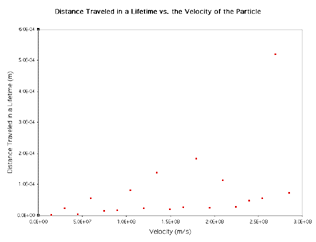| You noticed when you plotted the computer-simulated data that it
was remarkably neat. This is not the way things happen. Remember that
4x10-13s is the half-life of the D0 meson. This
means that it is the average lifetime of that particle. There is a
wide range of lifetimes that the individual D0 mesons can have.
Using the half-life as the de facto lifetime in your plot
simplified it. In a real experiment, where the lifetimes of the mesons
vary widely, the twenty computer-simulated points you plotted on the last page would be more likely to look like the twenty-point graph to the right on this page – not very pretty. In fact, given these twenty points, one would think that the best curve is a line, and that the point in the upper right is some sort of error. If you instead look at one thousand data points, you can see how much clearer the curve becomes.
That is why physicists who work on these experiments collect many
thousands of data points. The E687 team observed and analyzed more than
eighty thousand charmed meson decays. As of April 6th, 1999, FOCUS (the
"sequel" to E687) has recorded more than eight hundred thousand charmed
meson decays and is still shooting for their goal of a million.
| 

|

